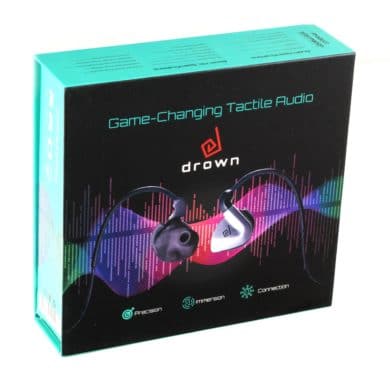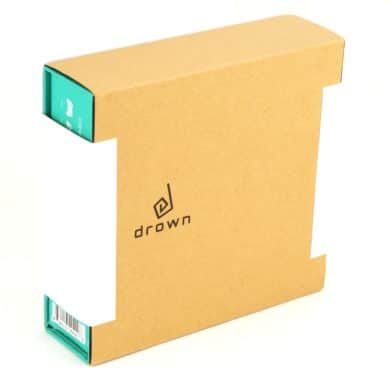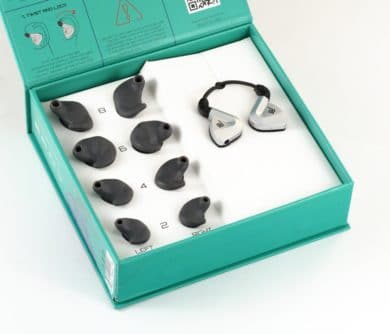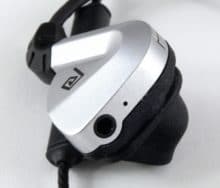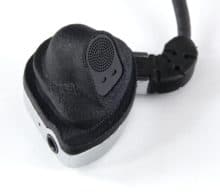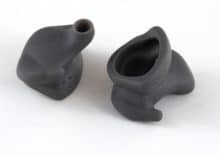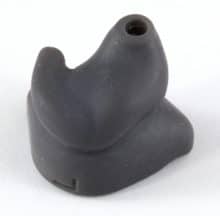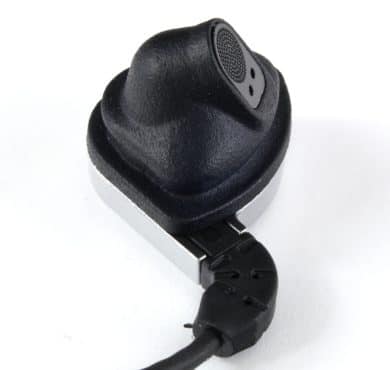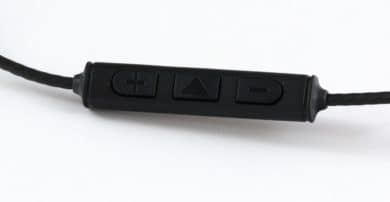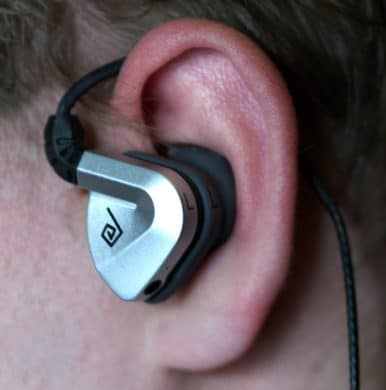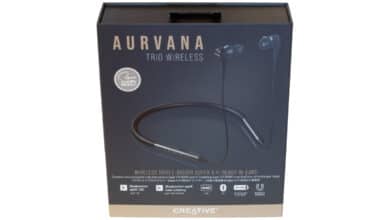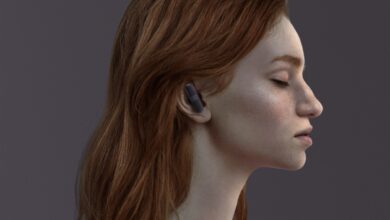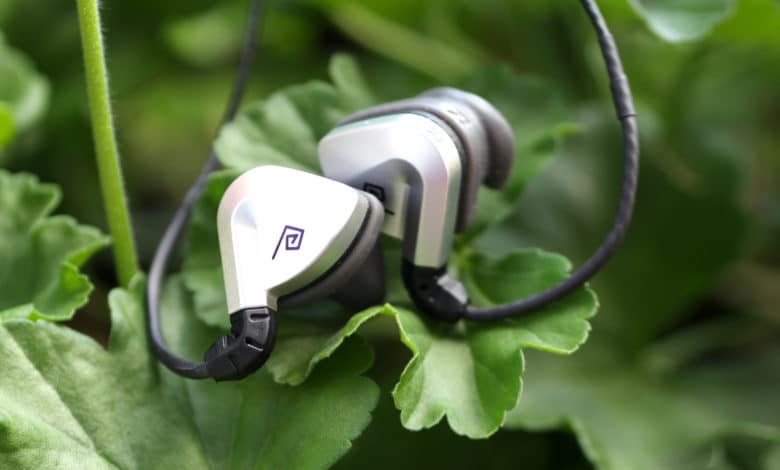
In August 2018, the young Scottish company Drown launched a crowdfunding campaign on Indiegogo. The campaign was to be financed with headphones with the simple name “Tactile Earphones”, which were to offer particularly high reproduction quality through a combination of classic sound reproduction and vibration generation in the auricle.
The financing of the Tactile Earphones was also a direct success: Drown was able to collect almost 38,000 Euros and start production. In June 2020, the Backer finally received their headphones, and in the meantime they are available for all other customers for a price of 155 pounds.
We will take a close look at the newcomers in the following test and explain what new approaches Drown is taking and how good the final result has been.
Scope of delivery
The Drown Tactile Earphones come in a small, colourful printed cardboard box with magnetic closure. Inside the box are, besides the headphones themselves, four different pairs of attachments, the two meter long connection cable, the pluggable microphone and a protective cover that can hold the most necessary accessories.
Specifications
| Connection: | USB C / 3.5 mm jack |
| Driver (speaker): | 14.8 mm, graphs |
| Impedance (speaker): | 35 Ω |
| Frequency range (loudspeaker): | 10-22,000 Hz |
| Frequency range (microphone): | 100-15.000 Hz |
| Weight (per listener, with attachment): | 10 g |
| Weight (microphone): | 4 g |
Design & workmanship
The Drown Tactile Earphones appear novel at first glance: The earphones are very large and almost triangular in shape. The left earpiece also serves as the base for the microphone: it can be plugged in at the bottom. Smooth silver plastic faces outwards, whereas the inside of the earphones is black and rough. The silicone caps are pulled over this surface and inserted into the auricle.
Unlike most headphones, the silicone caps of Drown Tactile Earphones are not simple, semi-circular inserts, but are adapted to the shape of the ear. How well this works will be discussed in the next section.
The headphones are wired, with the cable connected via a strain relief and a connecting thin earhook. After every 32 cm of cable, the connections converge in a male USB C plug – this is where the connecting cable is connected. This in turn is two meters long and ends in an angled TRRS plug. On the left cable is also the remote control, which can be used to pause songs and adjust the volume.
Unfortunately, the cabling of the Drown Tactile Earphones is not perfect, as a USB-C socket is needed for connecting the headphones, so alternative connection cables are hard to get. Additionally, we would have liked the cable remote to be a bit closer to the connector, so that it is a bit easier to reach.
The workmanship of the headphones is impeccable. Their individual housing segments are solid and connected with clean gaps, there are no negative conspicuous features. The cables are very thin and according to Drown are sheathed in Kevlar. Regardless of the conspicuous choice of material, we can confirm that the slightly structured sheathing makes a very robust impression, but is still flexible enough for all common applications.
Carrying comfort & transport
The silicone attachments are one of the most important features of the Drown Tactile Earphones. After all, they are supposed to ensure reflection-free sound transmission, make the vibrations of the music perceptible in the auricle and, of course, be comfortable.
For this purpose Drown supplies four different sizes to cover the different ear shapes. So before using the headphones, you first have to approach the target size – from small to large. Once this has been found, the cap is simply pulled over the listener, with the orientation being determined by the shape of the housing. Then follows the insertion of the headphones, which requires some practice but is very easy after a few minutes.
Each headphone is held individually to the ear. Then the “holding pin” is inserted into the ear with a twisting movement backwards and the headphones are already reasonably tight. The final fixation is then made by the holding bow, which is pressed against the base of the ear. This may sound complicated, but with a little practice it can be done very quickly and ensures that the headphones are held firmly in place.
The wearing comfort of the Drown Tactile Earphones is of course even more dependent on a fitting ear shape than in normal headphones, but the four included sizes were sufficient to find a very, very comfortable pair, at least in our tests. With this, you won’t feel the headphones even after hours of wearing them, and they fit tight enough not to fall out during sports. The same applies with a connected microphone: here, too, the headphones sit stable and very comfortable.
One problem of the Drown Tactile Earphones is only the size, which makes the transport a bit difficult. For this, Drown includes a protective case in which the headphones, the cable as well as a set of silicone caps fit in without any problems. Due to the size of the headphones, the cover has to be quite bulky – so it’s not really comfortable to carry the headphones in your pocket.
Recording and sound quality
The most important element of the Drown Tactile Earphones is of course the sound quality, and here the newcomers can fully convince. The whole repertoire of full-bodied marketing promises with which the headphones are advertised is, of course, a bit exaggerated, but they still offer a very good sound.
Especially when it comes to bass, the in-ears get surprisingly deep without booming. And there are no weaknesses in the mid to high frequencies either. The sound sounds voluminous and rich in detail – all potential points of criticism that one might have here, we would therefore put down to personal preferences.
The advertised “feeling” of the sound can also confirm this: Low frequencies are somewhat more perceptible in the auricle and on the scalp than usual when the silicone attachments are correctly positioned. We wouldn’t call this feature life-changing, but the one or other enthusiast might get the final “kick” here.
Ambient noise can only be filtered out by the headphones to a limited extent, as the noise suppression is exclusively done by the damping of the silicone attachments. Thus, the Drown Tactile Earphones can’t keep up with a real, active noise suppression – but they can with all other headphones.
The microphone could also convince us in the test. Due to the very compact dimensions and the correspondingly limited membrane size, no miracles are to be expected of course, but the microphone surprisingly performs better than many a competing product.
Despite the lack of pop protection, the noise is within the frame – if you don’t place the microphone in front of your mouth, you’ll even get all the way around it. The voice pickup isn’t quite neutral, but background noise is almost completely suppressed – the microphone of the Drown Tactile Earphones is therefore very well suited for on the go.
Conclusion
Many crowdfunding projects have gone astray, and some have turned into products that were not as good as promised. Fortunately, this is not the case with the Drown Tactile Earphones [manufacturer website], because the Scottish company behind the in-ears has indeed succeeded in producing very, very good headphones – at least if you refer to the sound alone.
The reproduction quality of the Tactile Earphones could fully convince us in the test: a deep, but not overflowing bass and a high level of detail in the higher frequencies. The removable microphone is also very well done for what it is.
We can’t complain about wearing comfort either, although this point is individually different. If the included inserts fit you perfectly, the Drown Tactile Earphones should be unrivaled in comfort. If they only fit reasonably, they are still very comfortable – even after hours of use. However, we can’t guarantee that the inserts are suitable for every ear type.
So far, we can attest the headphones a “perfect” fit, but at the end, there are unfortunately still a few points of criticism, especially concerning the cable. We would have preferred a female USB-C connection on the headphones, so that the continuing cable can easily be replaced. Moreover, the cable remote control should have been placed a bit further down. But these points aren’t really dramatic – you should only keep them in mind when buying.
Finally, the price remains, which is 155 pounds (~170 euro). That’s a lot of money for headphones, and in this price range we would have liked to see additional features like active noise suppression. But of course you have to look at the price: It’s the company’s first product and the headphones probably haven’t (yet) arrived on the mass market. Nevertheless: The Tactile Earphones may not be a bargain, but they are definitely very high-quality everyday in-ears, which can also replace a PC headset without any problems.
Drown Tactile Earphones
Workmanship
Wearing comfort
Sound quality
Recording quality
Features
Value for money
91/100
Very good, but also expensive in-ear headphones.
